The word combination trans-sylvania is a Latin term for “across (on the other side of) the woods”. That begs the question “other side for whom?” In this case, for the Hungarians. Their adopted homeland (after invading from the Eurasian steppes) is a vast prairie, which they call the Alföld, though most English, Slavic, and Germanic-speaking people call it Pannonia or the Carpathian Basin or the Great Hungarian Plain. Hungary’s eastern flank was covered with forests, rising to imposing mountains (the Carpathians) to the east, north, and south. Hungarians call this forested region Erdély, which translate as “forest region”. However when Hungarians converted to Catholicism, Latin-speaking clergy began keeping written records. Thus the Latin-based word Transylvania became well-established in Western literature before the Hungarian Erdély.

Hungarians ruled Transylvania from the time they arrived, about 1000, to 1920 (except for a brief occupation by the Ottomans). However they were not the only ethnic group in the area. Romanians were the vast majority, arriving- more than a thousand years before the Hungarians. Jews were there when Transylvania was called Dacia, a colony of the Roman Empire, around AD 100. There were also a significant number of Saxon Germans, invited by the Hungarians beginning around 1100. The earliest record of Roma in Transylvania dates from around 1400, when they appear among a list of slaves in Făgăraş.
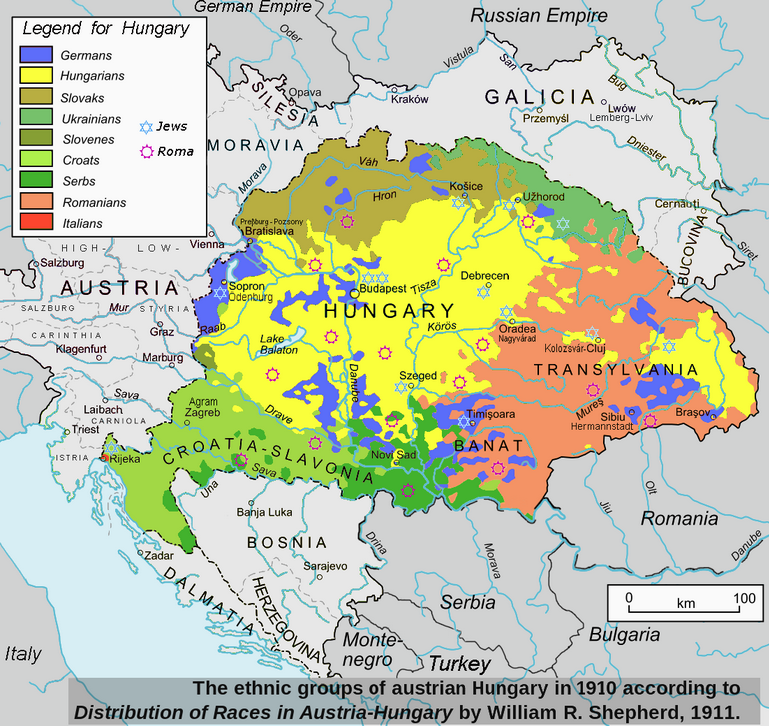
The word for Transylvania in all the neighboring languages varies according to which culture influenced them. The first known written occurrence of the Romanian name Ardeal appeared in a document in 1432 as Ardeliu. The Romanian Ardeal is derived from the Hungarian Erdély, Romanians also use Transilvania. Erdel, Erdil, Erdelistan, & Transilvanya are the Turkish equivalents. Russian: Ардял, romanized: Ardyal, Трансильвания Transil’vaniya. Serbian: Ердељ/Erdelj, Трансилванија/Transilvanija. Romani: Transilvaniya.
Saxon German immigrants called their adopted land Siweberjen a local dialect of German Siebenbürgen, (seven castles) after seven (ethnic German) Transylvanian Saxon cities in the region. This is also the origin of the region’s name in many other languages, such as the Croatian Sedmogradska, the Slovak: Sedmohradsko, the Bulgarian Седмиградско (Sedmigradsko), Polish Siedmiogród, Yiddish זיבנבערגן (Zibnbergn), and the Ukrainian Семигород (Semyhorod).
To further complicate things, some people consider all Romanian territory west and north of the Carpathians to be Transylvania, while others exclude the relative lowlands of the regions of Banat, Crișana and Maramureș. For the purposes of this article, I’m with the exclusionists and Wikipedia, calling the darker orange region below Transylvania proper.

Geography of Transylvania proper
The geography of Transylvania proper, as well as Romania in general, is defined by its crescent of mountains – the Carpathians – a curved backbone. While for many countries a mountain range defines its border, for Romania, mountains are its heartland. Romania has been repeatedly invaded from all directions, so the native population has survived by “heading for the hills”, where local knowledge of vast forests, caves and passes, counter the invaders’ military might.
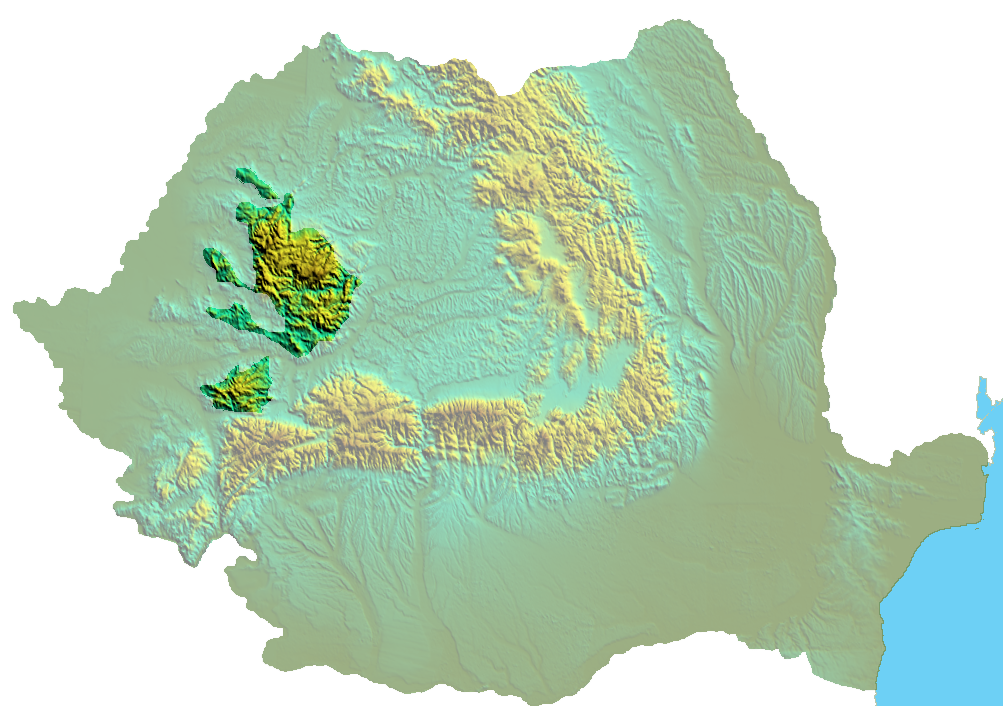


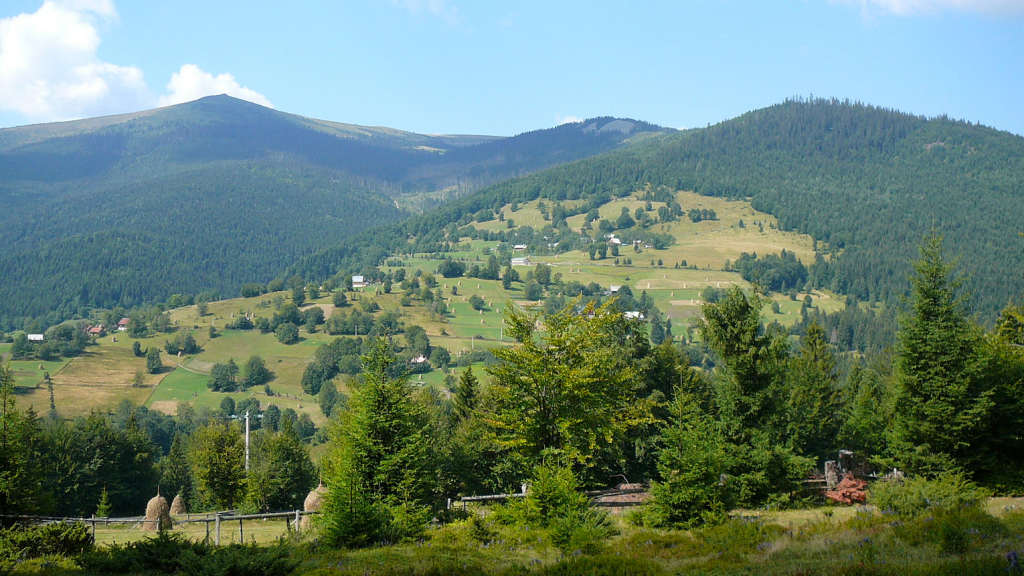
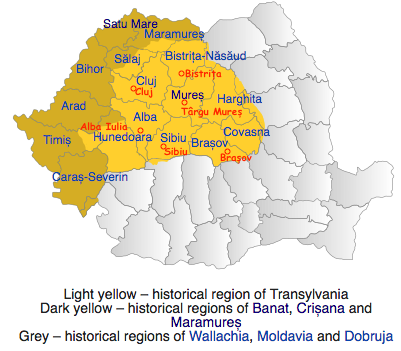
According to Wikipedia: The most populous cities as of 2011 census (metropolitan areas, as of 2014):
- Transylvania proper:
- Cluj-Napoca – 324,576 (375,251 in metropolitan area). Cluj-Napoca, commonly known as Cluj, is the second most populous city in Romania, after the national capital Bucharest, and the seat of Cluj County. From 1790 to 1848 and from 1861 to 1867, it was the official capital of the Grand Principality of Transylvania.
- Brașov – 253,200 (398,462). Brașov is an important tourist destination, being the largest city in a mountain resorts area, and a central location, suitable for exploring Romania, with the distances to several tourist destinations (including the Black Sea resorts, the monasteries in northern Moldavia, and the wooden churches of Maramureș) being similar.
- Sibiu – 147,245 (208,894). Sibiu is one of the most important cultural centres of Romania and was designated the European Capital of Culture for the year 2007, along with the city of Luxembourg, and it was formerly the centre of the Transylvanian Saxon culture and between 1692 and 1791 and 1849–65 was the capital of the Principality of Transylvania.
- Târgu Mureș – 134,290 (181,162) is a major Szekler (Hungarian) cultural centre.
- Bistrița – 67,272 (75,076) was a major trading hub with sizeable German, Hungarian, and Jewish populations. Jews were forbidden to live there until 1848 – by 1930 they comprised 16% of the population. In 1947 1,300 Jews resettled, but by 2002 only about 15 remained.
- Alba Iulia – 63,536 (109,484). Alba Iulia is a city located on the Mureş River in Alba County, and since the High Middle Ages, the city has been the seat of Transylvania’s Roman Catholic diocese. Between 1541 and 1690 it was the capital of the Eastern Hungarian Kingdom and the latter Principality of Transylvania. Alba Iulia also has historical importance because at the end of World War I, representatives of the Romanian population of Transylvania gathered in Alba Iulia on 1 December 1918 to proclaim the union of Transylvania with the Kingdom of Romania.
People of Transylvania proper/Ardeal – the Romanians
Humans have occupied Transylvania proper for hundreds of thousands of years. However the first occupants of which we have written knowledge were the Dacians of about 3000 years ago. They were the northern cousins of the Thracians. Click: the Geto-Dacians.
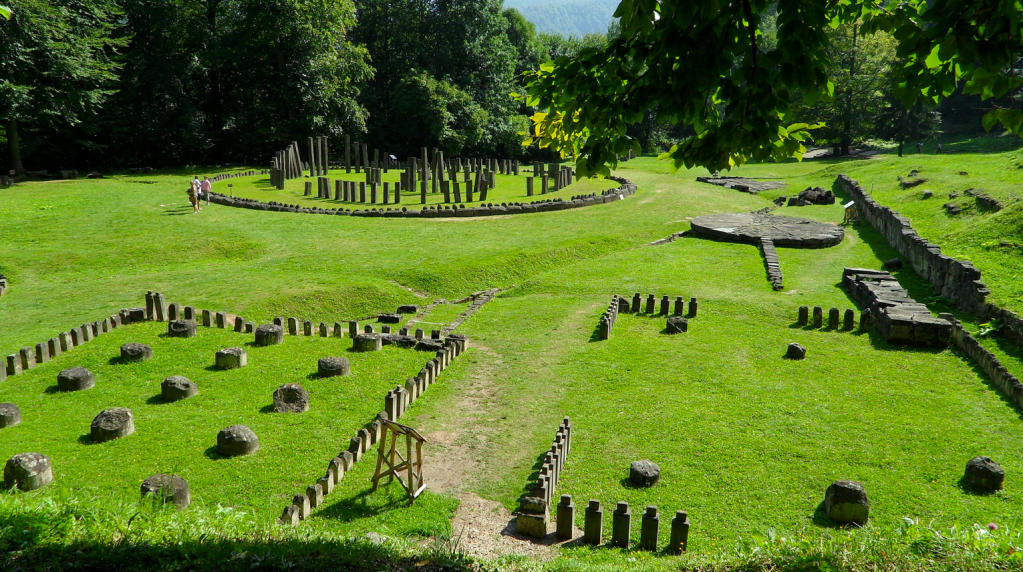
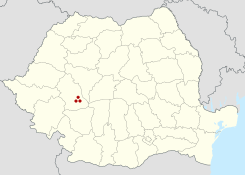
Dacia was autonomous until 106 AD, when the Roman emperor Trajan defeated the Dacians. The Romans ruled for 165 years. Roman soldiers were often paid in land, many soldiers homesteaded in their new territory, and natives adopted their language. Today’s Romanian language is as close as Europe has to the vernacular Latin tongue spoken by Roman soldiers, though about 16% of its vocabulary is Slavic in origin. Romanians call themselves after their preferred overlords. However during the Communist era the rulers, celebrating their pagan past, named the Made in Romania automobile the Dacia. Since the 106, Romanians have been conquered and subjugated by many people – not becoming fully autonomous again until 1878, and not reaching its present boundaries until the end of WWII.
Romanian blood may be predominately Dacian, but with traces of Romans, Hungarians, Germans, Celts, Goths, Gepids, Avars, Bulgarians, Serbs, Roma, Turks, Greeks, Ukrainians, Gagauz, Macedonians, Turks – anyone who has passed through their land. People considered Romanian account for about 70% of the population of Transylvania, according to the most recent census (2011).
Romanians may live in cities, but their heart is in the villages – their ancestral home – so I’m concentrating on YouTubes of village life.
People of Transylvania proper/Erdély – the Hungarians (Szekleys)

Wikipedia: “The Székelys (Hungarian pronunciation: [ˈseːkɛj]), sometimes also referred to as Szeklers…. are a subgroup of the Hungarian people living mostly in the Székely Land in Romania. The origin of the Székelys has been much debated. It is now generally accepted that they are descendants of Hungarians (or of Magyarized Turkic peoples) transplanted to the eastern Carpathian Mountains to guard the frontier, their name meaning simply “frontier guards”…..In the Middle Ages, the Székelys played a role in the defense of the Kingdom of Hungary against the Ottomans in their posture as guards of the eastern border.
Szekler people, Romania’s Hungarian speaking minority live in Gyimes, which now lies within Bacau county. The history of the area and its association with Transylvania, is very complicated …. I am no historian and apologise for any errors I have made.
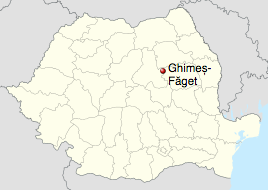
People considered Hungarian account for about 18% of the population of Transylvania, according to the most recent census (2011).
People of Transylvania proper/Siweberjen/Siebenbürgen – the German-Saxons
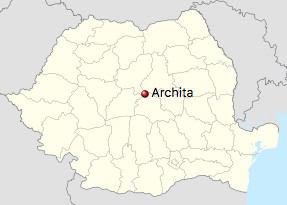
People considered German account for about 1/2% of the population of Transylvania, according to the most recent census (2011).
People of Transylvania proper/Transilvaniya – the Roma
Whereas very few Saxons remain in Transylvania, the Roma are a significant and rapidly growing minority. There are speculations they entered Transylvania with Genghis Khan’s invasion of 1241, though as slaves, craftsmen or servants is not known. The earliest written evidence of Roma in Transylvania dates from around 1400, when they appear among a list of slaves in Făgăraş. As Transylvania was Hungarian territory until 1920, many Transylvanian Roma speak Hungarian as their mother tongue and are of the sedentary musician tribes.
A good article on Roma in Transylvania today can be found here https://www.wildtransylvania.com/p/roma.html
Here’s a good Romanian Roma overview. https://covinnus.com/history-roma-people-romania/
For a look at Roma in Hungary and Romania in 1929, read https://folkdancefootnotes.org/culture/ethnicity-history-geography/gypsy-romani-encounters-1929-by-walter-starkie/
For more on the Roma in general, click https://folkdancefootnotes.org/culture/ethnicity-history-geography/roma-or-gypsies-why-2-names-and-where-do-they-come-from/ and https://folkdancefootnotes.org/culture/ethnicity-history-geography/roma-gypsy-cultures-central-value-marime/ and https://folkdancefootnotes.org/dance/dance-information/romani-gypsy-music-dance/
People considered Roma account for about 4% of the population of Transylvania, according to the most recent census (2011). The real percentage is likely much higher, as Roma are notoriously difficult to count.
People of Transylvania proper/Zibnbergn – the Jews
The famous Yiddish-American theatre song “Rumania, Rumania” by Aaaron Lebedeff extols tongue-in-cheek the delights of being a Jew in that country.
Most stories of Romanian Jews speak of Wallachia, Muntenia, Moldavia, Bucovina – regions outside of Transylvania, but closer to Russia and Poland – the other side of the “Pale” of settlement. The only YouTube I could find covering Romanian Jews that is specific to Transylvania is
According to tradition, King Decebalus (ruled Dacia 87-106 CE) permitted the Jews who aided him in his war against Rome to settle in his territory. They have been in Transylvania ever since, though they were seldom treated with honour or respect.
Ironically, Jews received better treatment during the Ottoman occupation. From Wikipedia: “While the Ottomans held sway in Hungary, the Jews of Transylvania (at that time an independent principality) also fared well. At the instance of Abraham Sassa, a Jewish physician of Constantinople, Prince Gabriel Bethlen of Transylvania granted a letter of privileges (June 18, 1623) to the Spanish Jews from Anatolia…But the community of Judaizing Szekler Sabbatarians, which had existed in Transylvania since 1588, was persecuted and driven underground in 1638.”
With the return of Hungarian and (later) Hapsburg rule in Transylvania, Judaism was suppressed or even outright forbidden, as in Bistrița until 1848. With the transfer of Transylvania to Romanian rule in 1920, however Jews were welcomed. By the 1930’s, Jews were flourishing in many parts of Transylvania, only to be nearly obliterated during the Holocaust. Those who survived and returned found life difficult under Communism, and many moved to Israel. Leaving Romania was made difficult, in part because the Communist government earned a substantial income extorting astronomical prices for exit visas – prices Israel was willing to pay. https://archive.seattletimes.com/archive/?date=19900101&slug=1048671
In the 2011 census, 3,271 declared themselves to be Jewish.
What about DRACULA?
Romanians including Transylvanians are known for their beliefs in the supernatural. Though Bram Stoker’s Dracula is a work of fiction, the dead are not to be trifled with by many Romanians today. They believe the dead are watching over us, and if we don’t honor them with certain rituals, their neglect will come to haunt the living. See https://folkdancefootnotes.org/culture/special-occasions/dancing-for-the-dead-joc-hora-de-pomana-banat-oltenia-romania-serbia-bulgaria/
See also: https://theculturetrip.com/europe/romania/articles/the-legends-and-myths-of-transylvania/
Comments:
John Uhlemann wrote: It was nice to see these areas, many of which my wife and I visited in 2019, and in the 1970s, again. I saw Viscri in 1978 and then again in 2019 – Prince Charles made sure that it was preserved the way it was. What the video does not make clear is that Viscri is now occupied by ethnic Romanians (the Germans all moved out in 1990). They were allowed to take over the houses provided that they not change the exteriors. This was done through the Eminescu Trust, set up by Prince Charles, who funded it, but was adamant about its remaining a Romanian function. You can’t see his name on anything, but the locals know what he did, and greatly respect him for it. We stayed one valley over in a restored German farmstead, now owned by ethnic Romanians, complete with German furniture . We also visited Archita (there is a video in this posting about that place). Just northwest of there, there is a sudden change to modern agrobusiness, and a consequent homogenization of the countryside. There is a terrible beauty to this place, and more even than you can get from this very nice compilation of videos. Thanks.
Don replied: Thanks, John for this invaluable information. Here’s a link to the Eminescu Trust you mentioned http://www.mihaieminescutrust.org/ , which offers a traditional Romanian experience at reasonable prices that fund the preservation of Romanian culture.
